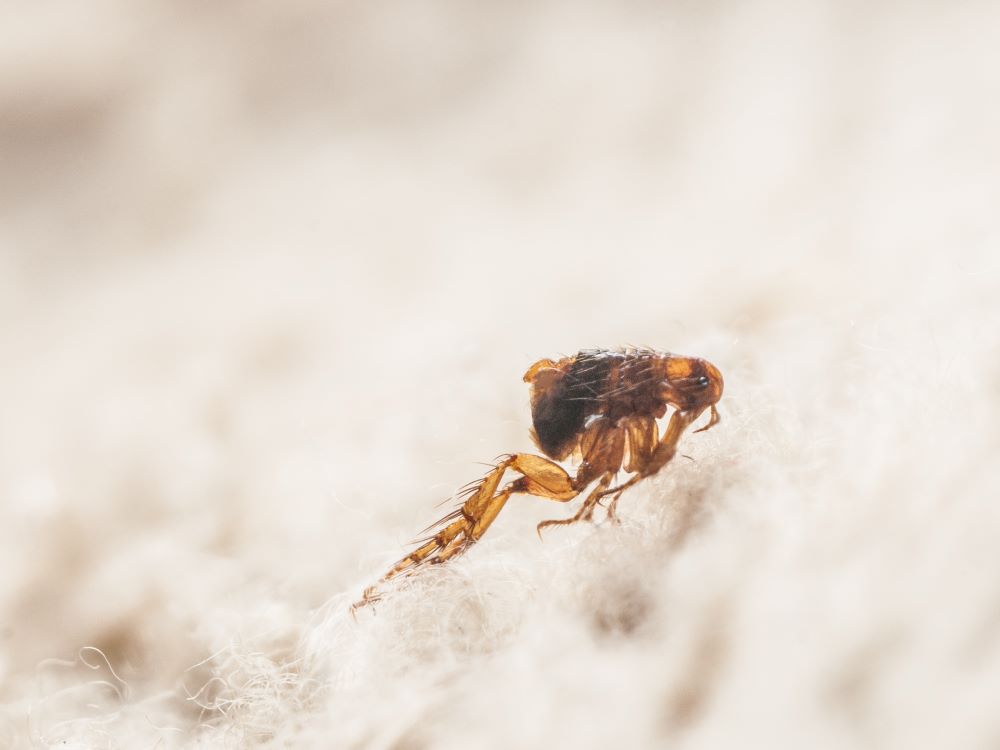Table of Contents
- The importance of identifying flea bites
- What do flea bites look like on dogs: signs and symptoms
- Common areas for flea bites on dogs
- The life cycle of fleas and how infestations occur
- Complications associated with flea bites on dogs
- Home remedies for treating flea bites
- Preventing flea infestations: Tips for dog owners
- When to consult a veterinarian for flea bites
- Conclusion
As a dog owner, you know that fleas can be a persistent and annoying problem for your beloved pet. Not only do these tiny parasites cause itching and discomfort, but they can also lead to serious health issues if left untreated. But what do flea bites look like on dogs? And how can you tell if your dog has been bitten by fleas?
In this comprehensive guide, we’ll explore the itchy truth behind flea bites on dogs, including the importance of identifying flea bites, signs and symptoms, common areas where fleas are most likely to bite, and the life cycle of fleas. We’ll also discuss complications associated with flea bites, home remedies for treating them, prevention tips for dog owners, and when it’s time to consult a veterinarian. So, let’s dive in and uncover the itchy truth about flea bites on dogs.
The importance of identifying flea bites
Flea bites are more than just a minor annoyance for your dog. They can cause severe itching and discomfort, leading to excessive scratching or biting at the affected areas. This, in turn, can result in skin irritation, inflammation, and even open wounds that can become infected if not treated promptly.
In addition to the physical discomfort, fleas can also transmit diseases and parasites to your dog, such as tapeworms or Bartonella (also known as cat scratch fever). Flea allergy dermatitis, a common allergic reaction to flea saliva, can also develop in some dogs, causing even more severe itching and skin issues.
By learning to identify flea bites on your dog and taking action to treat and prevent flea infestations, you can help protect your pet’s health and well-being.
What do flea bites look like on dogs: signs and symptoms
Flea bites can be challenging to spot, especially on dogs with thick fur. However, there are some key signs and symptoms that can help you determine if your dog has been bitten by fleas:
- Itching and scratching: One of the most obvious signs of flea bites is excessive itching, scratching, or biting at the affected areas. Your dog may also be more restless than usual or have difficulty sleeping due to the discomfort.
- Red, irritated skin: Flea bites can cause redness, swelling, and irritation in the affected areas, which can become more pronounced if your dog is allergic to flea saliva.
- Small, raised bumps: Flea bites often appear as small, raised bumps or welts on your dog’s skin. These may be red or pink in color and may feel warm to the touch.
- Hair loss: In severe cases, your dog may lose hair in the areas where they have been bitten by fleas, particularly if they are excessively scratching or biting at the skin.
- Flea dirt: Flea dirt, or flea feces, can often be found on your dog’s coat, particularly in areas where fleas are most likely to bite. This may appear as small, dark specks or flakes, which can be easily mistaken for dirt or dandruff.
Common areas for flea bites on dogs
Fleas are most likely to bite your dog in areas where their fur is thinner and their skin is more accessible. Some common areas where flea bites are likely to occur include:
- The base of the tail: This is a popular spot for fleas to bite, as it is relatively easy for them to reach and provides good cover from your dog’s attempts to scratch or bite at them.
- The groin and inner thighs: The skin in these areas is typically thinner and more exposed, making it an attractive target for fleas.
- The armpits: Like the groin, the armpits provide a warm, protected environment that fleas find appealing.
- The belly: Fleas may also target your dog’s belly, particularly if they have a thin or sparse coat in this area.
- The ears and face: In some cases, fleas may bite your dog’s ears or face, particularly if they have thin fur or are already infested with fleas.
The life cycle of fleas and how infestations occur
Fleas have a complex life cycle that consists of four stages: egg, larva, pupa, and adult. Understanding this cycle can help you better understand how infestations occur and how to effectively treat and prevent them.
Eggs: Female fleas lay their eggs on your dog’s coat, where they can easily fall off and become dispersed throughout your home. These eggs are tiny, white, and oval-shaped, making them difficult to spot with the naked eye.
Larvae: After about two days, the eggs hatch into larvae. These worm-like creatures feed on organic debris, such as dead skin cells and flea feces, and can be found in carpets, bedding, and other areas where your dog spends time.
Pupae: After about a week, the larvae spin protective cocoons and enter the pupal stage. Pupae can remain dormant for several months, waiting for the right conditions (e.g., warmth, humidity, or the presence of a host) before emerging as adult fleas.
Adults: Adult fleas are skilled jumpers and can easily leap onto your dog when they come into contact with infested environments. Once on your dog, they feed on their blood and reproduce, starting the cycle all over again.
Complications associated with flea bites on dogs
As mentioned earlier, flea bites can lead to complications if not treated promptly. Some potential issues that may arise from flea infestations include:
- Flea allergy dermatitis: This is a common allergic reaction to flea saliva, which can cause severe itching, redness, and inflammation in affected dogs. In some cases, it may even lead to hair loss, scabs, or open sores.
- Infections: Open wounds caused by excessive scratching or biting at flea bites can become infected, leading to further complications and potential health risks for your dog.
- Anemia: In severe infestations, the blood loss caused by numerous flea bites can lead to anemia (a deficiency of red blood cells), which can be life-threatening if left untreated.
- Tapeworms: Fleas can transmit tapeworms to your dog if they ingest an infected flea while grooming themselves. Tapeworms can cause digestive issues, weight loss, and other health problems if not treated.
Home remedies for treating flea bites
If you suspect your dog has been bitten by fleas, there are several home remedies you can try to help alleviate their discomfort and treat the bites:
- Cold compresses: Applying a cold compress to the affected areas can help reduce inflammation and provide some relief from itching.
- Oatmeal baths: Oatmeal has soothing properties that can help alleviate itching and irritation. Mix some colloidal oatmeal with water to create a paste, then gently apply it to the affected areas on your dog’s skin. Alternatively, you can add some colloidal oatmeal to a warm bath and let your dog soak for 10-15 minutes.
- Aloe vera gel: Aloe vera has natural anti-inflammatory and soothing properties that can help reduce redness and irritation caused by flea bites. Apply a thin layer of aloe vera gel to the affected areas on your dog’s skin.
- Apple cider vinegar: Dilute apple cider vinegar with an equal amount of water, then apply the solution to your dog’s skin using a spray bottle or a clean cloth. This can help soothe itching and irritation.
- Epsom salt baths: Epsom salt can help reduce inflammation and soothe irritated skin. Add a cup of Epsom salt to a warm bath and let your dog soak for 10-15 minutes.
Preventing flea infestations: Tips for dog owners
Preventing flea infestations is essential for the health and well-being of your dog. Here are some tips to help you keep fleas at bay:
- Regularly groom your dog: Keeping your dog’s coat clean and well-groomed can help deter fleas and make it easier for you to spot any signs of infestation.
- Use flea preventatives: Talk to your veterinarian about the best flea preventative options for your dog. This may include topical treatments, oral medications, or flea collars.
- Keep your home clean: Regularly vacuum your carpets, floors, and furniture to remove any flea eggs, larvae, or pupae that may be present. Wash your dog’s bedding and toys frequently.
- Treat your yard: Fleas can thrive in outdoor environments, so consider using flea control products in your yard to help prevent infestations.
- Check for fleas regularly: Regularly inspect your dog for any signs of flea bites or infestations. This can help you catch and treat any issues before they become more severe.
When to consult a veterinarian for flea bites
While home remedies can be helpful in treating flea bites, it’s essential to consult your veterinarian if:
- Your dog’s symptoms worsen or do not improve after trying home remedies
- Your dog develops signs of infection, such as swelling, pus, or a foul odor around the bites
- Your dog is experiencing severe discomfort, lethargy, or loss of appetite
- You suspect your dog may have a flea allergy or other complications related to flea bites
Your veterinarian can recommend appropriate treatments for your dog’s specific needs and help you develop a comprehensive plan for preventing future flea infestations.
If you’re concerned about potential flea bite allergies, please consult this article from VetDerm.
Conclusion
Flea bites can cause significant discomfort and health issues for your beloved pet, but by learning to identify the signs and symptoms of flea bites, you can take the necessary steps to treat and prevent infestations. Remember to consult your veterinarian if you have any concerns about your dog’s health or if you need guidance on treating flea bites and preventing future infestations.
If you have a flea infestation, RECON Pest Services is here to help. Serving the greater Omaha & Lincoln areas, we can handle even the peskiest of fleas. Contact us for a free quote!
By taking a proactive approach to flea prevention and treatment, you can help ensure your dog’s health and well-being. Regular grooming, the use of flea preventatives, and keeping your home and yard clean are all essential steps in preventing flea infestations. However, if you do notice signs of flea bites on your dog, it’s important to take action promptly.
Home remedies, such as cold compresses, oatmeal baths, and aloe vera gel, can provide temporary relief from itching and irritation. However, if your dog’s symptoms persist or worsen, it may be necessary to consult your veterinarian for more advanced treatment options.
Ultimately, by staying informed about flea bites and taking preventative measures, you can help ensure that your dog remains happy, healthy, and free from flea infestations. And if you do need assistance with flea control, don’t hesitate to reach out to RECON Pest Services for expert help and guidance.





